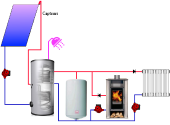Thew exhaust emissions are measured as a %age of CO2, or a %age of O2 as a proportion of the 21% of the normal atmospheric O2 level. Typically the CO2 would be in the range 8% to say 13%. The maximum possible is 15% but you have to have some excess air so that smoke is not produced. The efficiency is calculated from the excess air measured and the flue gas temperature. This is the combustion efficiency and is different from the overall efficiency which is feindishly difficult to measure anyway.
http://www.engineeringtoolbox.com/stoichiometric-combustion-d_399.html
http://www.engineeringtoolbox.com/boiler-combustion-efficiency-d_271.html
A couple of links for you. I work on oil boilers, and the measurements are a lot easier than for RMHs, but you will probably find them a bit taxing, I certainly do. Sequestering CO2 is best done by growing plants, like trees is a good example. Though I think it is good you have the attitude of trying to minimise the effect your activities have, don't try too hard with this from a combustion point of view unless you have enough land to grow the trees. You will never achieve a 0% carbon footprint. Even if you got anywhere near it for the wood heater, using a computer puts it straight out of the window, a gigabyte download uses over 7kWH!! that's a 1 bar electric fire for the working day.
A voice against shale gas fracking would be a far better gain than undue concerns about RMHs.
http://www.youtube.com/watch?v=JYaC7L2svoQ&feature=results_main&playnext=1&list=PL83053A81DD96D0FD This is an amazing video, the first 4 minutes are tedious introduction but Deborah tells a disturbing story.
http://www.situstudio.com/blog/2010/10/08/hydraulic-fracturing/ the wells in Utah
http://www.crystalbard.co.uk/decombustion/?p=687
This should put your stove into perspective. Keep up the enthusiasm.
PS I am really only a stop gap for basic information, there are other people on this forum who really know their stuff, and it's a lot more than I know.











